Crawling Into History: David Černý's Žižkov Tower Babies Turn 25
Kathy Zabinski

It’s been exactly 25 years since ten giant crawling babies first appeared on Prague’s Žižkov Television Tower, now one of the capital’s most recognizable features.
On May 29, 2000, Czech sculptor David Černý transformed the controversial broadcast structure into an icon of modern art—and stirred both fascination and outrage.
Originally intended for the Museum of Contemporary Art in Chicago, the aluminum babies made their Prague debut as part of the city’s European Capital of Culture celebrations.
Suspended across the tower’s vertical columns, the toddlers immediately polarized public opinion. But over time, they’ve become an inseparable part of Prague’s skyline—odd, surreal, and deeply local.
Identical versions of the babies, known in Czech as Miminka, are displayed on Kampa Island, standing freely on the grass. Viewed at ground level, their barcode-stamped faces reveal a more disturbing commentary—one that hints at Černý’s reputation for blending humor with subversive critique.
The artist’s intent wasn’t to charm, but to provoke questions about identity, surveillance, and dehumanization.

From Temporary Installation to Permanent Fixture
The original installation lasted only six months. In October 2000, the babies were removed, and their fate remained uncertain. But just a year later, they returned—this time indefinitely.
With the exception of a brief absence between 2017 and 2019 for restoration, the figures have become a lasting part of the tower’s structure.
In fact, the original babies were eventually replaced altogether. Due to weather damage and wear, new versions were created and reinstalled in March 2019.
Would you like us to write about your business? Find out more
-
NEWSLETTER
Subscribe for our daily news










